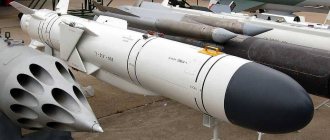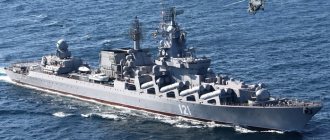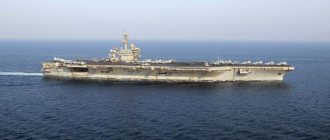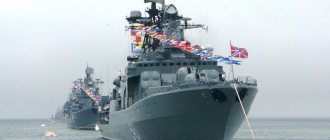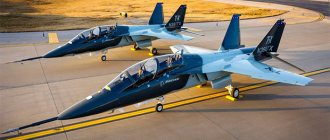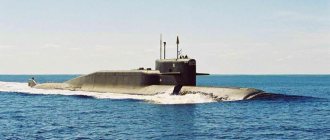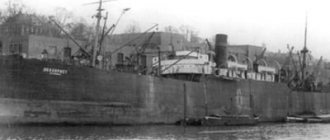In 1982, at the shipyard of the Nikolaev Shipyard named after. 61 Communards (Ukraine) in a solemn ceremony launched the Project 1164 missile cruiser “Marshal Ustinov”. This combat unit was already the second Atlant-class ship built as part of the State Defense Order. The new ship was named in honor of Marshal Dmitry Fedorovich Ustinov - Minister of Defense of the USSR 1976-1984.
Four years later, a new and powerful missile cruiser became part of the Northern Fleet, receiving permanent registration at the North Sea Naval Base. By that time, the Soviet Project 1164 missile cruisers, according to the NATO classification “Slava klass,” were considered the most powerful non-aircraft-carrying surface ships in the world. With a displacement of 9800 tons, the cruiser could reach a maximum speed of 32 knots. Armed with Basalt anti-ship cruise missiles, the new Soviet ship posed a real threat to NATO carrier groups at sea. Western experts, having assessed the combat capabilities of the new missile cruisers of the USSR Navy, deservedly gave them the nickname “aircraft carrier killers.”
Full-fledged combat service of the Northern Fleet's surface ship began in the spring of 1987 and continued until 1994, when it was decided to put the military vessel under preventative repairs.
From that moment on, a new history of the warship began, which continues to be written to this day.
First stage of modernization
Initially, the cruiser had quite decent tactical and technical characteristics and fully met the combat missions assigned to the domestic fleet. Until 1994, the cruiser actively participated in the combat life of the fleet, making long sea crossings. The ship was on combat duty in the Mediterranean Sea and repeatedly visited ports on the East Coast of the United States and Canada. In 1994, it was decided to put the ship under scheduled maintenance, which dragged on for three long years. Shipbuilders from the St. Petersburg shipyard began restoring the ship's combat capability. During this time, the ship underwent its first major modernization.
The primary task was to put the main hull in order, strengthen the components and assemblies of the propulsion system on the Project 1164 cruiser “Marshal Ustinov” and equip the ship with new fire extinguishing systems. A new, more powerful power plant was installed on the ship, capable of simultaneously providing economical sailing and a quick transition to forced mode. In addition to technological measures, the warship was supposed to receive new weapons.
The main striking force of the RKR was the Basalt anti-ship cruise missiles (PKR-500). The missiles were placed in 16 launch containers located permanently on the upper deck. The flight range of the cruise missile was 500 km. At the same time, the missile flew to the target along a complex trajectory, misleading the enemy’s radar and its entire air defense system. The mass of the missile warhead could reach 1000 kg. Despite the impressive combat parameters, by the mid-80s the P-500 Basalt anti-ship missile system ceased to meet the assigned tasks. The air defense systems of foreign navies have been equipped with new anti-missile systems capable of shooting down a Soviet missile during its marching flight at high altitudes.
Subsequent modernization of the missile led to the emergence of a new version of the P-1000 Vulcan anti-ship missile system, which was equipped with the third ship of the Chervona Ukraine missile cruiser series, now the Varyag missile cruiser of the Pacific Fleet. The naval command decided to re-equip the repaired warship with the new P-1000 Vulcan anti-ship system.
However, the modernization of the main strike weapons on the Marshal Ustinov RKR took place in a limited form. The installation of more powerful cruise missiles on the ship was carried out without replacing the SM-248 launchers, which turned out to be unsuitable for launching Vulcan cruise missiles as standard. The cruiser was equipped with P-1000 cruise missiles, equipped with starting engines from the old Basalt missiles. Accordingly, the range of the new strike weapons remained at the same level. The new anti-ship complex on the second cruiser of Project 1164 turned out to be in a truncated form. They tried to increase the flight range of the new missile system by reducing the weight of the warhead, but this negated the combat effectiveness of this class of weapons.
Note: The third production missile cruiser “Varyag” was originally equipped with Vulcan anti-ship missiles, which is why the launch containers were made of heat-resistant materials that had a long service life.
With new weapons, the repaired Project 1164 cruiser "Marshal of the Soviet Union Ustinov" could be considered a completely combat-ready combat unit, an alternative to the heavy nuclear missile cruisers of the "Orlan" type of Project 1144. Having comparable offensive and defensive weapons, the Russian ship in terms of combat equipment began to correspond to the best Western analogues , cruisers and destroyers URO.
It should be noted that the modernization of the ship, carried out in the mid-90s, did not affect the air defense system at all. The cruiser's main air defense weapon remains only 8 revolver-type launchers of the Fort anti-aircraft missile systems, created on the basis of the S-300 land air defense system. The close line of air defense was carried out by the old Osa-M air defense systems, which could only solve a limited range of combat missions. The reluctance to strengthen the means of combating the air threat is explained by the need to introduce the cruiser into the operational fleet of the fleet as quickly as possible. Re-equipping the ship with new types of air defense could significantly slow down the already protracted repairs.
The modernized ship, in the form in which it was put back into service, corresponded to the modern naval doctrine of the Russian Navy - powerful mobile strike formations of ships, covered by naval and carrier-based aircraft.
Combat service of a ship in modern conditions
Project 1164 ships, in particular the Marshal Ustinov and the missile cruiser Moskva, continue to constitute the striking power of the Russian fleet on the northern and southern flanks, being part of the Northern and Black Sea fleets. In the Far East, the Varyag RKR, the third ship in the series, continues to carry out combat service.
In modern conditions, ships continue to remain quite strong combat units, however, in terms of the level of radar and navigation equipment, missile cruisers are constantly in need of improvements. In 2001, new navigation equipment was installed on the cruiser Marshal Ustinov. The cruiser was equipped with space communications and positioning equipment, which significantly improved its combat capabilities.
The ship's subsequent service was associated with overseas campaigns as part of the aircraft carrier group of the Northern Fleet and combat patrols in the North Atlantic. The cruiser has repeatedly taken part in tactical and strategic exercises of the Northern Fleet. Intensive use of the vessel has led to real physical wear and tear of structural elements. A number of other vital systems of the ship have exhausted their technological resources. A new, major overhaul of the ship began in 2011, when the cruiser once again moored at the factory wall of the Zvezdochka Center in Severodvinsk.
The high naval command decided to carry out the next scheduled repair of the ship and, if possible, modernize the ship. In November 2012, the cruiser began its land service and was put back on the slipway. Initially, it was planned to carry out only preventative repairs on the cruiser, but in the process of studying the condition of the hull and the performance of the main components and assemblies, it became clear that the ship needed more thorough repairs.
Missile cruiser "Marshal Ustinov"
The cruiser "Marshal Ustinov" is a Soviet and Russian missile cruiser, the second ship of project 1164 "Atlant", part of the Northern Fleet. Built at the shipyard named after 61 Communards in Nikolaev. Named in honor of the USSR Minister of Defense, Marshal of the Soviet Union Dmitry Fedorovich Ustinov. The main purpose is the destruction of enemy aircraft carrier groups, the fight against light fleet forces, the defense of formations of warships and convoys of ships, fire support for the coastal flanks of ground forces and ensuring the landing of amphibious assault forces, laying minefields. Home port - Severomorsk.
Main tactical and technical characteristics of the cruiser "Marshal Ustinov"
Main tactical and technical characteristics of the cruiser "Marshal Ustinov"
Speed: 32 knots Crew: 296 people Navigation endurance: 30 days
Dimensions
Standard displacement: 6500 tons Total displacement: 7940 tons Maximum length: 156.5 meters Maximum beam: 17.2 meters Draft: 5.96 meters
Power plant
2 steam turbines GTZA-647 50,000 hp each, 2 fixed pitch propellers
Armament
2 twin AK-130/54 artillery mounts, 4 30 mm six-barrel AK-630 artillery mounts, 2 quad launchers of P-270 Moskit anti-ship cruise missiles, 2 RBU-1000 six-barrel rocket launchers, 2 anti-aircraft missile launchers " Calm", 2 twin 533 mm torpedo tubes. There is 1 Ka-27 helicopter on board.
On January 9, 2022 , from the cruiser Marshal Ustinov, Supreme Commander-in-Chief of the Russian Armed Forces Vladimir Putin observed the progress of joint exercises of the Northern and Black Sea fleets in the Black Sea. More than 30 ships, a submarine and aircraft were involved in the maneuvers. During the exercise, aircraft launched Kinzhal systems, and ship crews fired Kalibr cruise missiles and Moskit anti-ship missiles.
On August 13, 2022, the Northern Fleet missile cruiser Marshal Ustinov set off on a long voyage. The cruiser led a detachment of ships and support vessels. It included the tugboat SB-406 and the medium sea tanker Vyazma. According to the plan, the North Sea troops will conduct exercises, including with ships of foreign navies, and visit the countries of the Mediterranean and Africa.
On December 5, 2022, the missile cruiser Admiral Flota Lobov completed combat training missions at combat training grounds in the Barents Sea to repel simulated air attacks by Su-33 fighters.
On July 4, 2022, the cruiser Admiral Fleet Lobov, together with the large anti-submarine ship Vice Admiral Kulakov, sailed from Severomorsk to the Baltic, where it took part in the main naval parade in St. Petersburg in honor of Navy Day.
On July 26, 1996, the cruiser "Admiral Fleet Lobov" participated as the flagship ship in the naval parade in St. Petersburg in honor of the 300th anniversary of the Russian Fleet.
On May 9, 1995, a Naval Parade was held in St. Petersburg to commemorate the 50th anniversary of Victory in the Great Patriotic War. For the first time in the history of the country, it became international, and ships of states representing the anti-Hitler coalition during World War II took part in it. "Admiral Fleet Lobov" took part as the flagship.
On November 5, 1986, the missile cruiser Admiral Fleet Lobov was renamed Marshal Ustinov and included in the Red Banner Northern Fleet.
On September 15, 1986, the missile cruiser Admiral Flota Lobov entered service.
On February 25, 1982, the missile cruiser Admiral Flota Lobov was launched.
On October 5, 1978, a missile cruiser named “Admiral of the Fleet Lobov” was laid down on the slipway of the Nikolaev Shipyard named after 61 Communards.
Commanders of the cruiser "Marshal Ustinov"
Commanders of the cruiser "Marshal Ustinov"
Veregin Vladimir Dmitrievich (1984-1989), captain 1st rank Frunza G.I. (1989-1991), captain 2nd rank Avakyants Sergey Iosifovich (1991-1996), captain 1st rank Kuliev I.N. (1996-1998), captain 1st rank Sobgaida A.V. (1998-2002), captain 1st rank Zhuga S.Yu. (2002-2005), captain 1st rank Kravchenko P.M. (2005-2008), captain 1st rank Neklyudov I.V. ( 2008-2011), captain 1st rank Alantyev S. G. (2011-2018), captain 1st rank Kuzmin V. V. (2018), captain 1st rank
Current state of affairs
During their stay on the slipway, the shipbuilders managed to restore the ship's fire-fighting system and put the components and assemblies of the propulsion system in order. The ship's shafts and propellers were replaced and the pitching stabilizers were repaired. The cruiser's hull was completely cleaned of old paint and repainted.
Upon completion of the slipway work with the hull, the ship was floated out again and transferred to the outfitting wall for subsequent repair and restoration work. As it turned out, more than 50% of all existing ship communications needed to be replaced on the ship. The modernization of basic communications, detection and navigation equipment is overdue. As for the defensive complex of the combat vessel, work here was aimed at improving the technical condition of the Vulcan anti-ship missile launchers. After modernization, the ship will have a full-fledged version of the Vulcan anti-ship missile system, which can significantly enhance the combat power of the cruiser. The flight range of the missile with a normal warhead will be 1000 km.
Despite the fact that the repair work was supposed to be completed in 2014, in accordance with the terms of the government contract, the delivery of the ship was constantly postponed. Only in the fall of 2016, the Project 1164 Atlant-class missile cruiser Marshal Ustinov began to undergo factory tests. The ship again arrived at its permanent base, where it had to undergo a set of acceptance tests.
The latest news, which is replete with the domestic media, indicates that today the restored and repaired warship is a full-fledged combat unit of the Northern Fleet. The plans of the high naval command included a decision to transfer the repaired cruiser to the Pacific Fleet to strengthen the combat capabilities of the Russian Navy in the Far Eastern maritime theater.
According to the latest data, the Project 1164 Atlant-class missile cruiser is already included in the Northern Fleet, having created, together with the Peter the Great TARKR, the main strike force of the Russian Navy on the northern flank. New navigation equipment and target detection tools made it possible to bring the ship in line with modern requirements for modern military vessels.
The successes and results of the modernization of the cruiser "Marshal Ustinov" demonstrated wide technical capabilities for improving the ships of this project. The remaining Project 1164 missile cruisers, the cruisers Moskva and Varyag, can be modernized in a similar way. Such large-scale events, according to the leadership of the Russian Navy, will not only extend the service life of combat ships of this class, but will also strengthen Russia’s naval power in the Black Sea and the Far East.
Story
From 1987 to 1989 made trips to the Mediterranean Sea. Twice (1989 and 1991) he visited the US Navy bases in Mayport and Norfolk on business trips. Was a participant in the parade in honor of the 300th anniversary of the Russian Navy as a flagship (1996, St. Petersburg). After signing the agreement in Minsk, he became a sponsor of Belarus (2001). At the end of the treaty, he took part in a campaign in the North-East Atlantic (2004). From the summer of 2008 to the summer of 2011 he was on duty in Antarctica (replaced the ship "Severomorsk" near the Spitsbergen archipelago). From 2011 to the present, the cruiser “Marshal Ustinov” has been undergoing modernization in the city of Severodvinsk, Arkhangelsk region.
